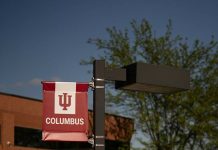Full development of the former Walesboro Airport could open up more than 500 acres of land for industrial development and cost the city about $45 million to develop, an engineering firm has indicated to Columbus officials.
HWC Engineering of Indianapolis presented a conceptual plan for how the airport property could be developed into an industrial park during a joint meeting Monday of the Columbus redevelopment and aviation commissions.
HWC senior planner and project manager Chris Hamm presented five phases of development for the property.
Phases 1A and 1B would initially open up about 140 acres of shovel-ready land on the western half of the property.
Phase 2 involves two options.
- Installation of new test-track facilities, which could be used by local manufacturers to test engines and other automotive parts. Cummins, Inc. and Faurecia already use existing runways at the former airport as test tracks for their products. The option also calls for the development of one parcel of land north of the test track.
- Avoid the test track and instead develop eight plots on that land.
Test-track facilities could be viable, Hamm said, which is why HWC created a plan that maintains the option to develop the facilities without forcing the city to make an immediate decision.
Phases 3 and 4 of the plan calls for development of the land surrounding the existing runways Cummins and Faurecia currently use as test tracks.
At full build out, the HWC plan proposes 509 acres of land for development with 39 available lots. If the test-track facilities are installed, only 32 lots would be available. The lots are designed to be easily combined into larger plots of land if necessary, Hamm said.
HWC also is suggesting improvements to County Roads 175 West, 150 West and 50 West as part of the development of the property.
The proposed project would cost an estimated $45 million.
However, HWC project engineer Sean Downey identified about $9.7 million in potential cost savings, such as installing dry detention ponds for drainage instead of wet ponds, or eliminating bike paths that would run along the external roads.
While choosing those options would cut down on costs, Hamm said they also would change parts of the overall development plan.
Dry detention ponds, for example, would eat up some of the acreage available for development, he said.
HWC also completed a fiscal impact analysis, which estimated annual revenues of $7.7 million in real property taxes, $5.6 million in personal property taxes and $2.2 million in local option income taxes at full buildout.
However, those estimates do not account for any potential tax abatements that could be awarded for development on the property.
Mayor Kristen Brown said HWC’s proposal laid a foundation that would enable the city to proceed relatively rapidly on the development of the property.
While there are enough funds in the Central Tax Increment Financing District to support the project costs, Brown said the next step in the process would be to determine exactly how the city would pay for the development. That will involve defining the parameters of the partnership between the redevelopment and aviation commission as the two groups continue to work together on the project.
Mayor-elect Jim Lienhoop, who will take office Jan. 1, said he was not able to attend Monday night’s meeting, so he and incoming city engineer Dave Hayward met with HWC representatives Friday to review the company’s plans.
Lienhoop said the development plan is appealing, but he also said the city needs to have an in-depth discussion on how it will fund the project. Like Brown, Lienhoop said he thinks a partnership between the two commissions likely will be the best option to pursue.
While he is generally pleased with the proposal, Lienhoop said he is concerned that the size of the lots HWC created on the property could be too small, even with the option of combining lots.
Before any major decisions are made about the development in the future, Lienhoop said he asked HWC to give an updated presentation early next year — likely in March — to new city officials who will take office Jan. 1.
[sc:pullout-title pullout-title=”By the numbers” ][sc:pullout-text-begin]
In its development plan for the former Walesboro Airport property, HWC Engineering proposed:
- 5 phases of development, with one phase dedicated to building a test track, if desired
- 39 lots and 509 acres of land available to develop at full buildout
- About $15 million in annual tax revenues
- About $45 million in total potential costs
[sc:pullout-text-end][sc:pullout-title pullout-title=”What’s next” ][sc:pullout-text-begin]
Outgoing Mayor Kristen Brown said the next steps in the process of developing the former Walesboro Airport property would be to determine exactly how the city will pay for the project and define the partnership between the city’s redevelopment and aviation commissions.
Mayor-elect Jim Lienhoop said HWC will give an updated presentation in March to bring newly elected and appointed city officials up to speed on the potential development of the property.
[sc:pullout-text-end]




